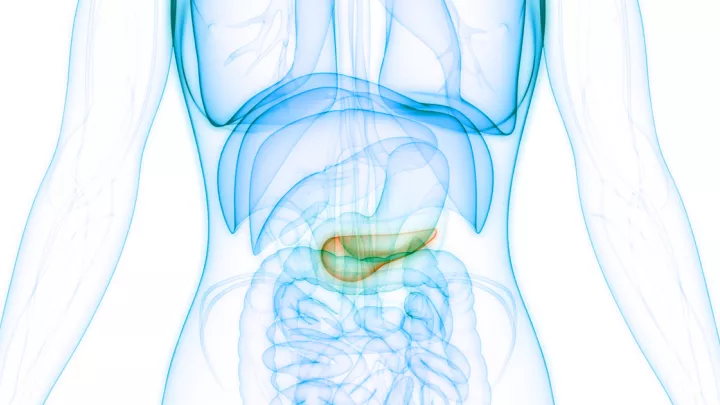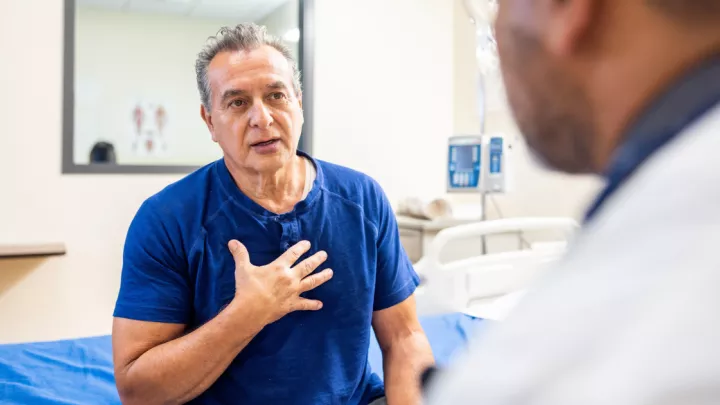Pancreatic cancer risk factors, symptoms and treatment options

The pancreas is an organ located in the back of the abdomen, behind the stomach. Its jobs are to produce and release insulin into the blood, which controls blood sugar, and to secrete enzymes into the intestine, which help to digest foods.
What is pancreatic cancer?
Pancreatic cancer happens when normal cells in the pancreas develop the ability to grow in an uncontrolled way and spread to other parts of the body. These cells grow into a mass or a tumor, which can affect the normal function of the pancreas and can spread outside the pancreas to lymph nodes or other organs, most commonly to the liver.
What are the risk factors for pancreatic cancer?
Any characteristics or habits that increase the chance of developing a disease are called “risk factors.” Having a certain risk factor does not mean you will develop the disease, and not having risk factors does not guarantee you will not get the disease. Risk factors for pancreatic cancer include the following:
- Obesity
- Smoking
- Having diabetes or chronic pancreatitis (inflammation or swelling of the pancreas)
- Having family members with pancreatic cancer, diabetes or chronic pancreatitis
- Certain hereditary conditions, including Lynch syndrome and hereditary breast and ovarian cancer syndromes (also known as BRCA1 and 2 mutations)
What are the symptoms of pancreatic cancer?

Kelsey Klute, MD
There is no symptom which is specific to pancreatic cancer, and many patients do not develop any symptoms of the disease. Pancreatic cancer can be found by chance on tests done for other reasons. Some patients with pancreatic cancer do develop symptoms, however, many of these symptoms can be caused by common conditions other than pancreatic cancer.
- Jaundice – yellowing of the eyes and skin, which can cause itching
- Light-colored stools, dark-colored urine
- Abdominal or back pain – can be worse after eating, can be worse when lying down
- Unexplained weight loss, loss of appetite
- Diarrhea or oily-looking stools
- Diabetes
- Fatigue or feeling very tired
You should talk to your doctor if you have any of these symptoms. These findings may help your doctor to order more testing to look for pancreatic cancer or other medical problems.
How is pancreatic cancer diagnosed?
Pancreatic cancer can be difficult to detect and diagnose for several reasons:
- Early pancreas cancer often does not cause any physical signs or problems
- The symptoms of pancreatic cancer are similar to the symptoms of many common problems, such as heartburn or back problems
- Pancreatic cancer can’t be detected with routine tests like X-rays or blood tests
Symptoms or abnormal blood tests can prompt your doctor to order more testing. If there is a tumor in the pancreas, it is best detected with a CT scan an MRI or an endoscopic ultrasound – a specialized type of ultrasound done from inside the stomach. If a tumor seen on a scan is suspicious for cancer, a biopsy is recommended. During a biopsy, a doctor obtains a piece of the tumor, which will then be sent to a pathologist – a doctor trained to diagnose diseases by performing special stains on tissue and looking at them under the microscope. Sometimes, more than one biopsy is needed to make an accurate diagnosis, which is important in deciding whether a tumor is a cancer, and if so, what type.
Are there different types of pancreatic cancer?
The majority of pancreatic cancers (95%) are pancreatic adenocarcinoma, a cancer that starts in the glands of the pancreas. Other types of pancreatic cancer are quite rare. Different types of pancreatic cancer behave very differently. They are treated very differently, so making an accurate diagnosis with a biopsy is important.
How is pancreatic cancer treated?
The prognosis (chance of cure) and options for treatment depend on several factors:
- The location of the tumor within the pancreas and how close it is to major blood vessels in the abdomen.
- Whether the tumor has spread outside the pancreas.
- The person’s overall health.
The options for treating pancreatic cancer include drugs (usually chemotherapy), surgery and radiation therapy. A combination of these treatments is recommended for many patients with pancreatic cancer, so pancreatic cancer is often treated by a team of doctors who manage each type of treatment.
Unfortunately, even after surgery, pancreatic cancer can later show up in other organs. This is because of cancer that we can’t detect with scans. Our CT and MRI scanners can only detect tumors measured in millimeters or centimeters; it takes millions of cancer cells to make up a tumor we can see on a scan. So even if we see only one tumor, we worry that there is cancer in other areas that we can’t see. We often recommend chemotherapy as the first treatment for pancreatic cancer, even if the tumor in the pancreas looks like it could be removed with surgery because chemotherapy is given into the bloodstream and circulates the entire body to treat cancer we can see, and any cancer we cannot see.
While many, but not all, patients with pancreatic cancer die from the disease, we approach each patient with pancreatic cancer individually. Our goal is to give each patient the best chance for cure.
We take an innovative approach to evaluating and treating patients with pancreatic cancer. Our Pancreatic Diseases Specialty Clinic offers patients with known or suspected pancreas cancer an expedited, comprehensive evaluation from a team of experts in pancreas cancer treatment, including medical oncologists, surgeons, radiation doctors, pathologists, radiologists, researchers, palliative medicine, pain management, nutrition, genetics, nursing, spiritual care, financial counselors and social work. Our team works together to provide coordinated, comprehensive and individualized treatment recommendations to patients during their visit to our Pancreatic Diseases Specialty Clinic.
We know that facing a diagnosis of pancreas cancer is incredibly overwhelming for patients and their loved ones. Our priority is to expedite diagnostic tests, discuss all possible options for treatment including experimental treatments, and support patients and their loved ones in making decisions about their health.








